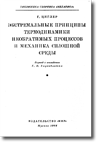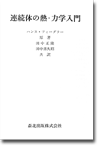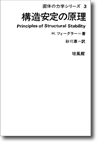 |
Publications by Hans Ziegler
Hans Ziegler issued Textbooks on Mechanics and Thermomechanics. Publications on Vibrations, Gyrodynamics, Structures, Elastic Stability, Critical Angular Velocities, Plasticity, Continuum Mechanics, Thermomechanics.
At the end of this list You will find a comment from Prof. Art Leissa from a contemporary viewpoint.
Books
- Mechanik I
(Statics of rigid, fluid, and elastic bodies), Birkhäuser, Basel 1946. 2nd ed. 1949, 3d ed. 1960, 4th ed. 1962, 5th ed. 1968.
Translation into Spanish, Dossat, Madrid 1951, into English, Addison Wesley, Reading, Mass. 1965.
- Mechanik II
(Dynamics of rigid bodies), Birkhäuser, Basel 1947. 2nd ed. 1956, 3d ed. 1962, 4th ed. 1966.
Translation into Spanish, Dossat, Madrid 1954, into English, Addison Wesley, Reading, Mass. 1965.
- Mechanik III
(Dynamics of systems), Birkhäuser, Basel 1952. 2nd ed. 1956.
- Kreiselprobleme - Gyrodynamics
IUTAM-Symposion Celerina 1962, Editor, Springer Berlin, 1963.
- Principles of Structural Stability
Ginn - Blaisdell, Waltham, Mass. 1968, 2nd ed. by Birkhäuser, Basel 1977.
Translation into Japanese, Baifukan, Tokyo 1974, into Russian, Uslatjel'stwo, Moscow 1971.
- Vorlesungen über Mechanik
(replacing I and II), Birkhäuser, Basel 1970. 2nd ed. 1977.
- An Introduction to Thermomechanics
North-Holland, Amsterdam 1977.
Translations into Russian and Japanese

Chapter 2 of «Progress in solid mechanics» Volume IV
Translation into Russian
Some Extremum Principles In Irreversible Thermodynamics
With Application To Continuum Mechanics
North-Holland, Amsterdam 1963, Moskau 1966

Translation into Japanese
An Introduction To Thermomechanics
North-Holland, Amsterdam 1977

Translation into Japanese
Principles of Structural Stability
Blaisdell Publishing Company A Division of Ginn and Company 1968
Articles in journals und newspapers
Hans Ziegler was Co-editor of:
Zeitschrift für Angewandte Mathematik und Physik
Ingenieur-Archiv
Advances in Applied Mechanics
Member of the editorial board, of:
Journal de Mécanique
Meccanica
Mechanics Research Communications
- Die Eigenschwingungen des Schwingers mit Spiel und Vorspannung, Schweiz. Bauz. 109, 135 (1937).
- Resonanz bei konstanter Dampfung (Diss.), lng. Arch. 9, 50 (1938).
- Die Querschwingungen von Kraftwagenanhängern, lng. Arch. 9, 96 (1938).
- Erzwungene Schwingungen mit konstanter Dämpfung, lng. Arch. 9, 163 (1938).
- Der Einfluss von Steigung und Bremsung auf die Querschwingungen von Kraftwagenanhängern, lng. Arch. 9, 241 (1938).
- Das Knicken der gedrückten und tordierten Schraubenfeder, lng. Arch. 10, 227 (1939).
- Ernst Meissner (Nachruf), Z. Angew. Math. Mech. 19, 192 (1939).
- Über die Grundlagen der technischen Mechanik (Antrittsvorlesung), Vierteljahresschr. Naturforsch. Ges. in Zürich 88, 186 (1943).
- Zur Kritik der technischen Biegungslehre, Schweiz. Bauz. 128, 187 (1946).
- Eine Erweiterung der technischen Biegungslehre, Schweiz. Bauz. 65, 17 und 30 (1947).
- Bending of bars of variable height, C. R. 6ème Congr. lnt. de Méc. Appl., Paris.
(Die Berichte sind nie erschienen.)
- Die Knickung des schief gelagerten Stabes, Schweiz. Bauz. 66, 87 (1948).
- Die Knickung des verwundenen Stabes, Schweiz. Bauz. 66, 463 (1948).
- Two-dimensional buckling of straight columns, Proc. 7th Int. Congr. of Applied Mechanics, London 1948, vol. 1, 409.
- Die Verbindungen bei den Leichten Truppen, Schrift 7 der Vereinig. Schweiz. Nachr. Offiziere, Bern 1948.
- Richard Grammel 60-jährig, Neue Zürcher Z. 3. 3. 49, Morgenausgabe, No. 438.
- Natürliche Eigenwertprobleme, 1. Mitt., zusammen mit E. Stiefel, Z. Angew. Math. Phys. 1, III (1950).
- Zur Knickgefahr der gedrückten Schraubenfeder, Schweiz. Bauz. 67, 404 (1949).
- Zur Knickung der gedrückten und tordierten Schraubenfeder, zusammen mit A. Huber, Z. Angew. Math. Phys. 1, 189 (1950).
- Näherungstheorie des astatischen Pendels, Vierteljahresschr. Naturforsch. Ges. in Zürich 95, 173 (1950).
- Stabilitätsprobleme bei geraden Stäben und Wellen, Z. Angew. Math. Phys. 2, 265 (1951).
- Ein nichtkonservatives Stabilitätsproblem, Z. Angew. Math. Mech. 31, 265 (1951).
- Zum Begriff des konservativen Systems, Elem. der Math. 7, 121 (1952).
- Die Stabilitätskriterien der Elastomechanik, Ing. Arch. 20, 49 (1952).
- Knickung gerader Stäbe unter Torsion, Z. Angew. Math. Phys. 3, 96 (1952).
- Kritische Drehzahlen unter Torsion und Druck, Ing. Arch. 20, 377 (1952).
- On linear elastic stability, Proc. 8th Int. Congr. on Theor. and Appl. Mech., Istanbul 1952, vol.1, 180.
- Torque on a thin shaft, a letter to the editor of Aircraft Engineering 24, 83 (1952).
- Die Stabilitätskriterien der Elastomechanik, Vortragsauszug, Z. Angew. Math. Phys. 3, 394 (1952).
- Zur Wirkungsweise der Ringwaage, zusammen mit H. Maag, Schweiz. Bauz. 71, 278 (1953).
- Linear elastic stability (a critical review of methods), Z. Angew. Math. Phys. 4, 89 and 167 (1953).
- Biegeschwingungen verwundener Stäbe, Vortragsauszug, zusammen mit A. Troesch und M. Anliker, Z. Angew. Math. Phys. 4, 317 (1953).
- Lateral vibrations of twisted rods, together with A. Troesch and M. Anliker, Quart. Appl. Math. 12, 163 (1954).
- On the concept of elastic stability, Advances in Applied Mech., vol. 4, 351 (1956).
- Zum Problem der grossen Spannweiten, Federhofer-Festschrift, Oesterr. lng. Arch. 9, 250 (1955).
- Der kardanisch gelagerte schnelle symmetrische Kreisel mit Lagerreibung, zusammen mit R. Grammel, lng. Arch. 24, 351 (1956).
- Der symmetrische Kardankreisel unter einem Moment an der Achse des äusseren Rings, Z. Angew. Math. Phys. 7, 253 (1956).
- Der schnelle symmetrische Kardankreisel mit Lagerreibung, Vortragsauszug, zusammen mit R. Grammel, Z. Angew. Math. Mech. 36, 278 (1956).
- Thermodynamik und rheologische Probleme. lng. Arch. 25, 58 (1957).
- An attempt to generalize Onsager's principle, and its significance for rheological problems, Ackeret-Festschrift, Z. Angew. Math. Phys. 9b, 748 (1958).
- Redundant trusses of elastic-strain-hardening material, J. Appl. Mech. 25, 233 (1958).
- Gyroscopes, in W. FIügge, ed., Handbook of Engineering Mechanics, Mc. Graw Hill, p. 25.1.
- Discussion of a paper by A. Slibar and P. R. Pasley, «The forced lateral oscillations of trailers», J. Appl. Mech. 25, 308 (1958).
- On Prager's hardening rule, together with R. T. Shield, Z. Angew. Math. Phys. 9a, 260 (1958).
- Kuppeln gleicher Festigkeit, Ing. Arch. 26, 378 (1958).
- A modification of Prager's hardening rule, Quart. Appl. Math. 17, 55 (1959).
- Meissner, Ernst, zusammen mit Elisabeth Graf, Biographisches Lexikon des Kantons Aargau 1803-1957, Sauerländer 1958, p. 521.
- Hochschule und Mechanik, Techn. Rundschau, Jubiläumsausgabe 50 Jahre TR, Dezember 1958, p. 25.
- Der Kampf gegen die Verkehrsunfälle; Erfahrungen eines Amerikareisenden, Neue Zürcher Z. 29. 9. 58, Morgenausgabe, No. 2791.
- Über einige Verfestigungsregeln, zusammen mit C. Clavuot, Grammel-Festschrift, Ing. Arch. 28, 13 (1959).
- Andreas Schopf, Neue Zürcher Z. 8. 10. 59, Abendausgabe, No. 3028.
- Mechanik im Grenzgebiet Fest-Flüssig, in E. Brandenberger, ed., Wissenschaftliche Grundlagen der Anstrichstoffe und Anstrichtechnik I, Schriftenreihe Forsch. Gemeinschaft Schweiz. Lackfabrikanten, Heft 4, 99 (1960).
- Bemerkungen zu einem Hauptachsenproblem in der Plastizitätstheorie, Z. Angew. Math. Phys. 11, 157 (1960).
- Über den Zusammenhang zwischen der Fliessbedingung eines starr-plastischen Körpers und seinem Fliessgesetz, Teil 1, Z. Angew. Math. Phys. 11, 413 (1960).
- Üeber den Zusammenhang zwischen der Fliessbedingung eines elastisch-plastischen Körpers und seinem Fliessgesetz, Teil 2, Z. Angew. Math. Phys. 12, 53 (1961).
- On the theory of the plastic potential, Quart. Appl. Math. 19, 39 (1961).
- Zwei Extremalprinzipien der irreversiblen Thermodynamik, Ing. Arch. 30, 410 (1961).
- Henry Favre, zum sechzigsten Geburtstag, Neue Zürcher Z. 10. 6. 61, Morgenausgabe, No. 2190.
- Die statistischen Grundlagen der irreversiblen Thermodynamik, Ing. Arch. 31, 317 (1962).
- Einige mit dem Prinzip der grössten Dissipationsleistung verträgliche Stoffgleichungen, zusammen mit Ch. Wehrli, Z. Angew. Math. Phys. 13, 372 (1962).
- Some extremum principles in irreversible thermodynamics, with application to continuum mechanics, Progress in Solid Mech., vol. 4, 91 (1963).
- Über ein Prinzip der grössten spezifischen Entropieproduktion und seine Bedeutung für die Rheologie, Rheol. Acta 2, 230 (1962).
- Some limiting cases of non-Newtonian fluids, Prager Anniversary Volume, Progress in Applied Mechanics, 317 (1963).
- Methoden der Plastizitätstheorie in der Schneemechanik, Z. Angew. Math. Phys. 14, 713 (1963).
- Plastische Berechnungsmethoden, Neue Zürcher Z. 4. 4. 63, Abendausgabe, Blatt 5, No. 1345.
- Plastische Berechnungsmethoden, Kurs für Bauingenieure und Maschineningenieure, ETH 25. bis 30. 3. 1963, zusammen mit B. Thürlimann.
- Thermodynamic aspects of continuum mechanics, CIME Summer Session III 1963, Bressanone.
- Thermodynamic considerations in continuum mechanics, The 1964 Minta Martin Lecture, published by MIT, Cambridge 39, Mass. with the AIAA, 1290 Ave. of the Americas, New York 20, N. Y.
- Thermodynamik der Deformationen, Hauptvortrag, Applied Mechanics, Proc. 11th Intern. Congr. Appl. Mech., München 1964, p. 99.
- Richard Grammel, Ansprache an der Akademischen Trauerfeier 22. 1. 1965, Reden und Aufsätze, Heft 31, Technische Hochschule Stuttgart.
- Zum Begriff des elastischen Körpers, zusammen mit D. Macvean, Z. Angew. Math. Phys. 17, 191 (1966).
- On the notion of an elastic solid, zusammen mit D. Macvean, Recent Progress in Applied Mechanics, The Folke Odqvist Volume, Stockholm and New York, p. 561.
- Zur Klassifikation von Kräften, zusammen mit Ch. Wehrli, Schweiz. Bauz. 48, 84 (1966).
- In memoriam Henry Favre, Schweiz. Bauz. 48, 84 (1966).
- A possible generalization of Onsager's theory, IUTAM-Symp. on Irreversible Aspects of Continuum Mechanics, Vienna 1966, Springer Wien 1968, p. 411.
- Zum Prandtlschen Stempelproblem, zusammen mit M. Sayir, Ing. Arch. 36, 294 (1968).
- Some developments in the theory of stability, Canadian Congr. of Appl. Mech., Centennial Year 1967, vol. 3, p. 233.
- Der Verträglichkeitssatz der Plastizitätstheorie und seine Anwendung auf räumlich unstetige Felder, zusammen mit M. Sayir, Z. Angew. Math. Phys. 20, 78 (1969).
- Zur Stabilität von Strömungen in geschlossenen Kreisen, zusammen mit P. Grassmann, Chemie-Ing.-Technik 41, 908 (1969).
- Übersetzung von Publikation 61 ins Russische durch G. I. Barenblatt, Biblioteka stornika «Mechanika», Moskau 1966.
- Trace effects in stability, IUTAM-Symp. on Instability of Continuous Systems, Herrenalb 1969, Springer Berlin 1971, p. 96.
- Zum plastischen Potential in der Bodenmechanik, Z. Angew. Math. Phys. 20. 659 (1969).
- Plastizität ohne Thermodynamik? Z. Angew. Math. Phys. 21, 798 (1970).
- Zum axiomatischen Aufbau der Mechanik, Elemente der Math. 26-2, 25 (1971).
- Proof of an orthogonality principle in irreversible thermodynamics, Z. Angew. Math. Phys. 21, 853 (1970).
- Sinn und Grenzen der Hochschulexperimente. Sachgerechte Reformen statt Schlagworte. Neue Zürcher Z. 21. 8. 1970, Morgenausgabe, No. 386.
- Incompressible Reiner-Rivlin fluids obeying the orthogonality condition, together with L. K. Yu, Ing. Arch. 41, 89 (1972).
- On the axiomatic structure of mechanics, translation of publication 84 into English, in H. H. E. Leipholz, ed., Stability, Study No. 6 Solid Mech. Division, Univ. of Waterloo, Waterloo, Ont., Canada 1972, p. 1.
- Thermomechanics, Quart. Appl. Math. 30, 91 (1972).
- Systems with internal parameters obeying the orthogonality condition, Z. Angew. Math. Phys. 23, 553 (1972).
- Zur Konvexität der Fliessfläche, zusammen mit J. Nänni und Ch. Wehrli, Z. Angew. Math. Phys. 24, 140 (1973).
- Orthogonality in continuum mechanics, Vortragsreihe, vorbereitet für einen Sommerkurs der Polnischen Akademie der Wissenschaften, Jablonna 18. bis 27. 6. 1973.
- Zur Konvexität der Dissipationsflächen, zusammen mit J. Nänni und Ch. Wehrli, Z. Angew. Math. Phys. 25, 76 (1974).
- Continuum mechanics, a powerful tool in solving ice and snow problems, Int. Symp. on Snow Mechanics, Grindelwald 1974, IAHS-AISH Publ. 114, p. 185.
- Eine neue Begründung des Orthogonalitätsprinzips, lng. Arch. 43, 381 (1974), samt Berichtigung in Ing. Arch.
- Nonlinearity in thermomechanics, J. Nonlinear Mech. 10, 145 (1975).
- Zur Kohärenz des laminaren Rieselfilms, zusammen mit H. Brauchli, Ing. Arch. 46, (1977).
- Grundprobleme der Thermomechanik, Z. Angew. Math. Phys. 28, (1977).
- Der zweite Hauptsatz als Folge des Prinzips vom Maximum der Entropieproduktion, Z. Angew. Math. Phys. 28, (1977).
- Fadenreibung in Abzugsdüsen, zusammen mit H. Brauchli, Melliland Textilberichte 59, 196 (1978).
- William Prager 75-jährig, Neue Zürcher Z. 24. 5. 1978, No. 117, S. 31.
- Discussion of some objections to thermomechanical orthogonality, Ing. Arch. 50, 149 (1981).
- 50 Jahre Erinnerungen, ETH-Bulletin 159 (November 1980).
- Arguments for and against Engesser's Buckling Formulas, Ing. Arch. 52, 105 (1982).
- The influence of inplane deformation on the buckling loads of isotropic elastic plates, Ing. Arch. 53, 61 (1983).
- Chemical reactions and the principle of maximal rate of entropy production, Z. Angew. Math. Phys. 34, 832 (1983).
- Erratum, Z. Angew. Math. Phys. 35, 441 (1984).
|
 |
 Chapter 2 of «Progress in solid mechanics» Volume IV
Chapter 2 of «Progress in solid mechanics» Volume IV Translation into Japanese
Translation into Japanese Translation into Japanese
Translation into Japanese